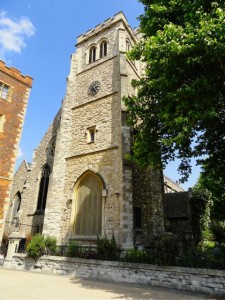
Today, we have a guest article from Dr Linda Saether who decided to go to Lambeth, after her time on The Executed Queens Tour, to track down the resting place of Elizabeth Boleyn (née Howard), mother of Queen Anne Boleyn.
Searching for the Grave of Elizabeth Boleyn, Countess of Wiltshire
by Dr Linda Saether
When the Countess of Wiltshire, Elizabeth Boleyn, drew her last breath on Wednesday the 3rd of April 1538, she wasn’t within the familiar walls of Hever Castle. Hever had been her home through most of the extraordinary life she had shared with her husband, Thomas Boleyn. Instead she drew her last breath at the home of Hugh Cook Faringdon, the Abbot of Reading, near Baynards Castle in London. This location would have been near the Millenium Bridge along the north bank of the Thames. Little if anything remains of Baynards now.
On April 9th of 1538 John Husee wrote the following to Lady Lisle:
“My Lady of Wiltshire was buried at Lambeth on the 7th. My Lord Comptroller was chief mourner for the men and Lady Dawbny of the women. She was conveyed from a house beside Baynard’s Castle by barge to Lambeth with torches burning and four baneys set out on all quarters of the barge, which was covered with black and a white cross. At her burial was the King of Heralds, a herald and a pursuivant.”1
Once at Lambeth she was brought to St. Mary’s Church where her body was laid to rest in a crypt beneath the floor of the Howard Chapel. The chapel had been the resting place for several of her Howard relatives from 1522 forward. At some point the graves would have been marked.
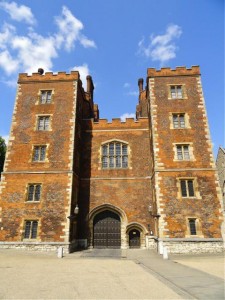
A headstone marked with the name Elizabeth Howard in St. Michaels in Framlingham, Suffolk, sometimes labeled Elizabeth Boleyn marks the grave of a child, not Elizabeth Howard, The Countess of Wiltshire, married to Thomas Boleyn whom we know lies in Lambeth.
While in London a few weeks ago, I made a trip to Lambeth in search of the grave of Elizabeth Boleyn, and answers to the many questions I have about this woman for whom I have found such empathy. Among these questions is why wasn’t she buried at Hever and why was she in London in April of 1538?
I walked along the south banks of the Thames, enjoying the view of the Parliament Buildings directly across from me and found St. Mary’s Church and Lambeth Palace only slightly further west on Lambeth Road.
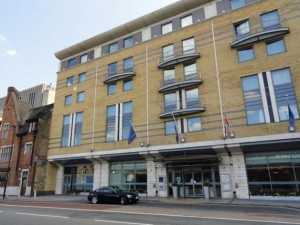
St. Mary’s must have looked similar when Elizabeth Boleyn visited the Howard Chapel. Much as it had been when the young Howard girl, who was to become Queen Catherine Howard, walked across the street to St Mary’s from Norfolk House. That was where she’d grown up as an orphan under the careless supervision of her Aunt Agnes, the Duchess of Norfolk. Today, The Novatel Hotel stands on the site where the Norfolk House once was and hotel guests now have the same view of St. Mary’s from their windows.
I spent a few moments outside of St. Mary’s in a small enclosed garden that looked unaffected by time or the bustle of modern London surrounding it. Old graves were now unmarked from the wear of centuries. Yet that little spot still looked unchanged by the passing of time. Even the plants looked as they’d appeared year after year in exactly the same fashion as though the many intervening gardeners had somehow known to leave things be.
St. Mary’s today is no longer a place of worship but has become the home of The Garden Museum. This much is made clear from signage on the exterior. All the same it was surprising to walk into a centuries old church and see the stone walls framing a very modern display of plant and garden items of all kinds.
At a ticket counter inside the foyer a smiling young woman asked me to make a donation to the museum. I did. And then I stepped forward on to the large pine floor of the nave facing the area where the altar once had been. There is no high altar now and there are no pews in the nave. The stone arches soaring above me and the exterior walls were as they had always been. Yet everything else had been cored out and transformed.
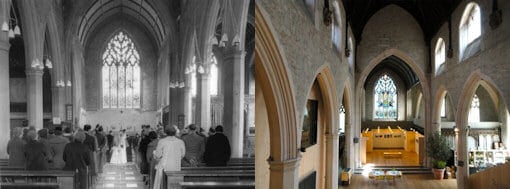
The blend of the ancient and the modern is startling as you step across the threshold of what you believe should be a solemn place of worship. There are plants everywhere. But in the area where worshipers sung their hymns there is still a wide open space.
A display wall covered with photos of flowers was placed across the altar space partially covering large black stone slabs in the floor. One inscription read : “Here lyeth the Body of Anne, late wife of Thomas Lord Archbishop of Canterbury. She departed this life on the XII of February MDCCXV”. This marks the tomb of the wife of Thomas Tenison, Archbishop of Canterbury.
I wanted to see the rest but there was no passageway behind the wall. To the right, in what must have been a small chapel, there’s now a gift shop. It sells cards, gardening gloves, tiny rakes, and gardening books.
I knew the Howard Chapel would be to the left and I felt a bit sad as I turned to see that the pine floor extended right through the chapel that had now become the museum coffee shop.
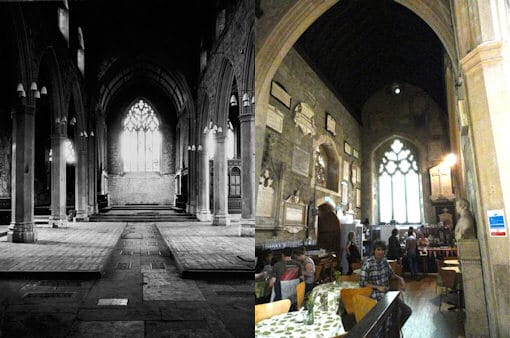
Where the young Catherine Howard had gathered her gown about her and sat obediently in the Howard pews, cafe lattes are now served.
Below that bleached pine floor of the cafe, having left so little to remember her by, rests the body of Elizabeth Boleyn. Nothing marks her grave or the graves of so many of her Howard family members, once one of England’s leading families.
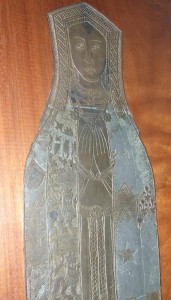
I asked the young cashier who’d accepted my donation to the garden museum if anyone could tell me about the church. This is when Phillip appeared and became my link to the past. He was kind enough to share a wedding photo he’d received from a woman who had married in the church in the 1950’s and another photo from renovations in 1977 when the original flooring had been covered. He also shared photos of the brass of Thomas Clere and Kathrine Howard, the Lady Effingham, and also the Duke’s of Norfolk Coat of Arms.
Philip also provided an extensive list of Howard family members buried at St. Mary’s. Among them were several of Elizabeth’s well married sisters who were buried here and not in their husband’s family crypts.
This gives rise to some interesting questions. Were Howard women expected to be “brought home” for burial in the Howard Chapel regardless of whom they married? Lady Elizabeth apparently had an extensive network of friends whom she visited so being in London was perhaps not unusual. But did she go to London and the home of the Abott of Reading because she knew she was dying?
In a letter to Lady Lisle on April 7th, Lady Frances Basset mentions in the midst of a news filled letter “My Lady Wiltshire died Wednesday before last”2. She then continues on with irrelevant news. Was so little said because her death was known to be long coming?
We don’t know if Thomas was at her side during her last days. We do know her sister Lady Katherine Howard, the audacious Lady Rhys, (Lady Daubney) mourned her at her funeral and later accompanied her to the same grave beneath the chapel floor in 1554 .
I left Lambeth having come close to the grave of Elizabeth Boleyn. I also left with more insight to the Howard family and more questions about their remarkable and interwoven lives than before.
Much thanks to Philip for sharing his abundant knowledge and caring for the church that will always be the final resting place for so many members of this remarkable family.
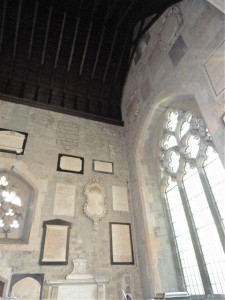
Burials in S Mary’s, Lambeth
- Thomas Howard, 2nd Duke of Norfolk – Born 1443. Died 21 May 1524 at Framlingham Castle. He was initially buried at Thetford Priory, which was destroyed in the dissolution of the monasteries, and then moved to the Howard Chapel, built in 1522. His flat gravestone of grey marble was recorded by Nichols in 18th century. Lived at Norfolk House. Son of 1st Duke and Katherine Molyns, husband of (1) Elizabeth Tilney and (2) her sister Agnes. Grandfather of Queen Katherine Howard and Queen Anne Boleyn. Defeated the Scots at the Battle of Flodden, created Duke and Earl Marshall of England in 1514.
- Agnes, Duchess of Norfolk, died 1545. Buried in Howard Chapel. Nee Tilney, 2nd wife (married 1497) of Thomas Howard, 2nd Duke of Norfolk who was earlier married to her sister Elizabeth. Lived at Norfolk House. Step-grandmother to Queen Katherine Howard and her ‘guardian’.
- Children of the 2nd Duke and Agnes (confusingly two daughters are called Elizabeth): John d.1501; John d.1503;
Charles d.1512; Henry d.1513; Richard d.1517; Elizabeth Howard, Lady Elizabeth Fitzwalter (or Fitzwater) d. 18 Sept 1534. 1st wife (m. before 21 May 1524) of Sir Henry Radcliffe, Earl of Sussex and Viscount Fitzwalter (or Fitzwater), Lord Egremont and Burnell, mother of Thomas & Henry (3rd & 4th Earls) & Robert. Attendant to Anne Boleyn when Henry VIII met Francois I at Calais in 1535. - Elizabeth Howard d.1538. Daughter of Elizabeth Tilney and Thomas, 2nd Duke of Norfolk. Wife of Thomas Boleyn, Earl of Wiltshire and Ormonde. Mother of Anne Boleyn (the 2nd wife of Henry VIII), sister of Lord Edmund Howard, aunt of Queen Katherine Howard; sister of Thomas, 3rd Duke of Norfolk
- Katherine Howard d.1554. Daughter of Thomas Howard, 2nd Duke of Norfolk and Agnes Tilney. 1st husband: Sir Rhys Ap Griffith (Thomas), 2nd husband: Henry Daubenay, 1st Earl of Bridgwater.
- Anne Howard, Countess of Oxford. Died 1558-9. Buried in Howard chapel. Daughter of Thomas Howard, 2nd Duke of Norfolk; wife of John de Vere, 14th Earl of Oxford.
Other family members/ connections buried in St Mary’s
- Katherine Howard d.1535, Lady Effingham. Daughter of John Broughton, wife of Lord William Howard (son of Thomas 2nd Duke of Norfolk) Treasurer and Earl Marshall of England, mother of Agnes Howard. Katherine and William were indicted for concealing the the misdemeanors of Queen Katherine Howard (their niece) and sentenced to imprisonment.
- Thomas Clere, d.1545. Youngest son of Sir Robert Clere of Ormesby in Norfolk, descended from De Cleremont family who arrived with William the Conqueror. Mother was a daughter of Sir Edward Boleyn and Margaret (daughter of Thomas Earl of Ormond). Thomas Clere was cousin of Queen Anne Boleyn. Epitaph written by the poet Henry Howard, Earl of Surrey, his confidential friend.
- Elizabeth Howard, Duchess of Norfolk, died Nov 1558. Buried in Howard Chapel in black marble table tomb. Lived at Norfolk House. Daughter of Edward Stafford, Duke of Buckingham (beheaded 1521), sister of Henry Lord Stafford. Married Thomas Howard, 3rd Duke of Norfolk, in 1512/1513 as his second wife (separated 1533 or 4); mother of Henry Howard Earl of Surrey and Poet (born 1516/1517) and Mary Howard, later wife of Henry Fitzroy, Duke of Richmond.
- Princess Anne of York, Lady Anne Howard – Born 2nd Nov 1475 at Westminster. Died winter 1512-13 of consumption (another date given is 1511) Lived at Norfolk House. Daughter of Edward IV, had 3 brothers, 6 sisters and 2 half-brothers, engaged to Philip only son of Mary of Burgundy & Emperor Maximilian of Hapsburg in 1480. First wife, in 1495, of Thomas Howard, Earl of Surrey, 3rd Duke of Norfolk. Children died young: 1)Henry Howard, Feb 1502. Buried in Howard Chapel – had brass plate. 2)Thomas Howard, died Aug 1508. Buried in Howard Chapel. 3)Charles Howard. Died 3 May 1512, Buried in Howard Chapel. 4)Henry Howard, died 22 Feb 1513. Buried in Howard Chapel. Lived at Norfolk House, Son of Thomas Howard, Duke of Norfolk and possibly Anne depending on the date of her death.
- Richard Howard, died 22 March 1517. Buried in Howard Chapel. Lived at Norfolk House. Son of Thomas Howard, 2nd Duke of Norfolk and Agnes Tilney (his 2nd Wife).
- Muriel (Marcella) Howard – Sister of Elizabeth Boleyn, died around 1512/1513, married to John Grey, Viscount Lisle (d. 1504) and then Sir Thomas Knyvet.
Associations with St Mary’s, Lambeth
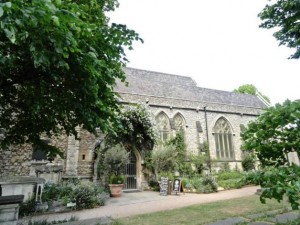
Katherine Howard (Queen), born c1521, executed 1542. Lived with her step-grandmother and ‘ guardian’ Agnes Tilney, Dowager Duchess of Norfolk at Norfolk House, Lambeth, opposite St Mary’s church. Henry VIII courted her there and they married at Oatlands Palace, she was his fifth wife. Daughter of Lord Edmund Howard (son of 2nd Duke of Norfolk) and Joyce (Jocasta) Culpeper (Colepeper).
Notes and Sources
- LP xiii part 1 717
- LP xiii. part 1 696
Meticulously researched, beautifully written. Found Dr. Saether’s article fascinating.
What a great article! I echo Prudy’s statement–very nicely done and those pictures, too. Elizabeth Howard is a fascinating woman–silent and mysterious I think. So little known about her but to have lost her children like that….so sad. I love tramping around old cemetaries–all those stories…Thanks so much!
I greatly enjoyed this article-it was a wonderful cobination of travel diary and historical mystery!
I was VERY excited when I saw the picture of the funeral brass of Catherine Howard-We have a copy of that (along with MANY others) in the education department where I work, so that our visitors can do brass rubbings!
How lovely that you found the informative Philip-While I am always saddened by how much of the past has been forgotton or built-over by new stores, hotels, etc, I usually find there is a Philip-esque individual who is ready to share the knowledge that I have been seeking!
How sad St. Mary’s is no longer a church and the graves of so many have been covered. The article is a wonderful tribute to a Lady of great sadness. Having lost a child, I can imagine the unbearable pain Elizabeth Howard Boelyn lived in for the last years of her life. Death must have been a welcomed relief/
Well written Dr. Linda!
Great article…
Such a shame that these historic sites are not kept intact for the dignity of the deceased but also for posterity’s sake. What guidelines does the historical society employ with regards to these matters?
Rosina
I don’t think that The Garden Museum have damaged the church in any way, I’m sure that the church is a listed building because of its history and that’s why they have simply laid the wooden floor on top of the floor and I suspect it’s just laid and not fixed down in any way. By the looks of it, it would be quite easy to take it back to its original condition and I suspect they had to do it like that.
It is sad to note that there is no marker for Anne’s mother. She was an important lady in her day and to see that nothing marks her passing is cruel. They should have at least put up a monument on the wall marking those who were buried there. At least she is not forgotten by history like so many others have been. I hope she is resting in peace waiting for the judgement day to come.
Wonderful article. It would be nice if the Garden museum could put up a display of photos showing what it used to look like.
What a fabulous article. I so enjoyed reading it. So nicely done. Thank you for your dedication and hard work Dr. Linda (and Claire, too!!). When I read these I can close my eyes and fell like I am right there.
I suppose it is better for the church to be used for another purpose than to be let fall into ruin.And although the graves are not on view, there are still there under the protection of the new flooring. I am suprized. though that there is no leaflet/wall plaques for people to read, it seems such a pity that visitors could walk away from such a historical place and know nothing about the history and importance of the family members that are laid to rest there. As for Elizabeth Boleyn I hope she is at peace now, because she had very little of that after the King became their ‘cuckoo in the nest’, and systematically destroyed her whole family. The pain she must have felt as she, helplessly, had to watch what was happening. Unimaginable.
I have often wondered where Elizabeth Howard Boleyn was buried. Also how she died.
I would imagine that after losing 2 of your children in such a tragic and violent way that she would have died of a broken heart as I suspect Thomas did also.
I agree with Shoshana that death would have been a welcome relief to her after her children’s death as well as being reunited with George and Anne.
I’d like to think that wherever they were after death that they had the ability to see Elizabeth become Queen and what a great Queen she was.
A wonderful article Linda, you are truly dedicated! It is such a pity that it is no longer a church and the graves of such a proud family are now hidden. There mush have been a good reason for turning it into a garden museum. Well done on your research, I have often wondered about why Elizabeth and her husband were buried apart and not having hr husband present in her final hours also. Maybe your article will bring forward some discussion in the forum and we may get our questions answered.
How sad that this historically important church has been changed into such a piece of modern rubbish! Aren’t there enough coffee shops in London?
It’s the coffee shop of the museum, not just a coffee shop. I think most museums and galleries have a coffee shop to fund themselves, but I do wish it had been left a church, so sad.
Why do you think of it as modern rubbish? It has been preserved in the original state of the building and protected. It is a museum and they guardian has done a good job to protect the tombs and the old floor and shape as much as possible. It’s not as if the Church is now a Costa. When it was no longer used it became a listed building and can’t be torn down like other Churches in London and some other cities. The museum does not look much different to the original building. And why is preserving something modern rubbish? I too wish it was still a Church but a Church needs a congregation and if nobody goes or you can’t keep a clergyman or the building is too expensive, sadly the Church has to make a realistic and economic decision. More information around the walls on the people there would be nice.
Thanks for the wonderful article Linda.
I have great compassion for Elizabeth Boleyn. I can not imagine the horror she went through losing her two of her children like that. Maybe she died from a broken heart.
I lost my beloved son, David 13 years ago and my heart is still broken. But I have Prozac!
Enjoyed meeting you last year and all the others. It was a special time and I am repeating it in July.
Anne,I am very sorry about your son and have 2 children of my own, I could not fathem how it would feel for any parent,I almost lost my daughter April 1 1987 in a horse accident she was olny six years old, she lost her left kidney and had a shatterd splien the out come did not look good for her,I still have nightmares of that day.She is now in her 30s and is a Horse Trainer and married to a Jockey.I worry every day! My prayers are with you and David is now with the Lord,you will see him again, be strong.Again I am heartfully sorry. King Regards Baroness Von Reis
Well done Linda! I know that you have spent many hours researching Elizabeth Boleyn, and I wish you the best of luck in your future research! So hoping to meet up with you again. =)
Fabulous reading, Linda, about the woman behind Anne. She has always fascinated me and your journey was written in way that I felt I was walking the cobblestones alongside you. Perhaps we could ask for a recognition of the Howard women in the church. I understand the need for repurposing historic buildings so we don’t lose them completely…and I agree with Claire that the flooring is probably not fixed so it could be restored to its original state easily. Why don’t we see what might be possible to do to acknowledge these women? Anyone up for seeing if we can mark the grave for Anne’s mother and Elizabeth’s grandmother? We can’t change history, but we can become it.
It’s a bit sad that she’s lying under the floor of a coffee shop. I wonder if Katheryn Howard attended her funeral? She would have been living at Lambeth then, so I’d bet she did. I wonder if it made her think about her cousin Anne at all?
Wonderful article, I enjoyed so much learning more about the resting place of many Howards.. I wish the church were still a place of worship and prayer and not a museum..
Great article! – just one query:
“Katherine Howard d.1535, Lady Effingham. Daughter of John Broughton, wife of Lord William Howard (son of Thomas 2nd Duke of Norfolk) Treasurer and Earl Marshall of England, mother of Agnes Howard. Katherine and William were indicted for concealing the the misdemeanors of Queen Katherine Howard (their niece) and sentenced to imprisonment”
If she died in 1535, how could she have been “indicted for concealing the the misdemeanors of Queen Katherine Howard” ? Was this during her girlhood befored she married HVIII?
Hi Molly,
Just sent Claire another article on Lambeth, as this is one of my special areas of research. I’ve cut a snippet from it which will answer your question.
Marilyn
Philip Norman and I discussed at the Garden Museum last autumn how erroneous information can become part of the supposed fund of true knowledge, a good example of which is the information that usually accompanies the Katherine Howard brass at Lambeth. We are told that she was the wife of Lord William Howard and was imprisoned with him in the Tower in 1541 for having concealed knowledge of Queen Katheryn Howard’s misdemeanours; this cannot be true as this lady died in 1535. The Lady Howard in the Tower was Lord William’s second wife, Margaret Gamage, and the misinformation has been handed down and not questioned since it was published in eighteenth-century histories – by eminent historians of the day, no less! This Katherine is also referred to as Lady Effingham, but her husband did not receive the manor of Effingham in Surrey until 1551, and did not become Lord Howard of Effingham until 1554, nearly twenty years after her death.
Last summer, me and my husband visited the church (or the museum of garden history) I is acctually very modest reshaped. One of your first english gardener (John Tradescant ) is buried there and he is the main reason of museums opening and also the survival of the church. So, no, the church wasn’t a listed building by the 1970’s and about to be destroyed.
The café fits well with the church and serves different kinds of cakes and food – mostly vegetarian and grown nearby- and you can also sit in the garden. It is a nice and peaceful place in the middle of London. If you want information on this areas history, the museum also provides it. I think it’s a wonderful way of preserving churches instead of demolish them, if you restore it with care. If your intrested in plants and stuff I hope you have time for a visit next time you’re in London. It’s a small museum so you can combine it with a visit at Lambeth House or, like we did, the jewel tower, just a short walk away.
http://www.gardenmuseum.org.uk
The Garden Museum is a lovely place but there is more information on the Tradescantia family (their graves are in the graveyard adjacent) than the Howards which seems a shame but not a surprise since gardening is a major passion in England. Perhaps we could get this rectified?
It has been suggested that Elizabeth was buried at Lambeth because she was estranged from Thomas Boleyn but the burial of so many Howard ladies puts flight to this myth eg Anne of York would probably have been buried at Windsor or Westminster Abbey as she was the daughter of a King. To be honest, I like the idea of all the Howard ladies, sleeping peacefully together. It makes a change from being buried alongside your husband!
Anne of York was initially buried at Thetford Priory where the first and second Dukes of Norfolk and the Duke of Richmond, Henry VIII’s son by Bess Blount and husband to Mary Howard, were also buried.
Thomas Howard, the Duke of Norfolk, wrote to his nephew pleading that the priory be left alone during the dissolution of the monasteries citing it as the burial place of the king’s own aunt and son. That letter can be found in Henry VIII’s letters and state papers.
Thomas Howard’s heartfelt plea fell on deaf ears. Henry didn’t even care about his own son remains. (or his sister Mary Tudor either) So Anne of York’s remains had to be moved. Some believe she was buried permanently at St. Mary’s where Thomas Howard’s second wife is certainly buried. Others believe Anne of York’s remains went from Thetford Priory to Norfolk House ultimately to Framlingham with her husband’s. It is almost certainly her effigy, not Elizabeth Stafford Howard’s, resting beside the third Duke of Norfolk at St. Michael’s Church.
It’s not true to say that Henry did not care about his son or sister’s remains.
Henry Fitzroy was re-buried in the church at Framlingham (alongside Mary Howard, his wife) and Mary Tudor was re-buried at St Mary’s parish church in Bury St Edmunds where there is a commemorative stone and window.
They are currently mapping the Howard tombs in Framlingham. I noted when I last visited that it’s interesting that Framlingham (in general with most of East Anglian churches) suffered heavily from iconclasm yet the Howard tombs with their abundant decoration, stand almost untouched.
I recently saw a three D reconstruction of the Tomb of Henry Fitzroy and you are correct, for although Henry, probably via Thomas Cromwell, turned down Norfolk on Tetford, he specifically instructed him to arrange the reburial of his son and told Norfolk to take care of it as he was in mourning for Jane Seymour. Norfolk sent him details and the King was content. Mary, his sister was moved and there is an appropriate, if somewhat modernised and moderate tomb next to the Abbey of Saint Edmund, in Saint Mary’s Church. The book on the mapping of the Howard Tombs at Framlington is fascinating.
This is the first time I’ve visited this site and thoroughly enjoy it. I really enjoyed this article and the pictures. I can’t imagine what Elizabeth must have thought as she watched all the machinations going on around her. She probably knew how it would all turn out knowing the players. Sad for her.
What an interesting article. Thank you to Linda for her research.
Thanks for this valuable article, Dr. Saether. After the second paragraph, I was startled to remember that I more or less stumbled upon St. Mary’s a couple of years ago one spring when Westminster Abbey was so crowded that I gave up trying to visit and walked across to Lambeth because Charlie Chaplin was born and spent much of his youth there. The church (and its garden) is still a lovely place, but there is a shocking lack of plaques, brochures and other readily available information about its long history and associations.
Thank you for such a wonderful article. I enjoyed it. I too have a fascination with the Howards and hope some day to visit St. Mary’s.
I did want to correct that Elizabeth Tilney was an only child. Agnes Tiley was NOT her sister as the author claims. She was Elizabeth Tilney Bourchier Howard’s cousin and the second Duke of Norfolk apparently received a special dispensation in 1497 to marry Agnes Tilney.
Also, the author, I believe, incorrectly attributes children to Anne of York and the third Duke of Norfolk (then Thomas Howard II). The author is correct that Thomas Howard III (d. 1508) and Henry Howard (d. 1502) were the children’s of the couple.
The Charles and Henry Howard that died in 1512 and 1513 were the children of the second Duke of Norfolk and Agnes Tilney. The Letters and State Papers of Henry VIII refer only to two sons. Other Howard articles refer to Charles and Henry Howard from 1512 and 1513 as the second Duke and Agnes’ children. If you read the Latin inscription on their brass plates this is made clear.
I do wonder sometimes about the 1497 date simply because it doesn’t seem like Agnes had a son until 1510.
Thank you both Linda and Claire,
This is a most remarkable research article. What a lot of difficulty and passion you must have. You have found Anne’s Mother! At last we can be rest assured that Elizabeth had been given the Grace of a Holy funeral. I hope that Elizabeth rests in peace, although I doubt it! The rattle of heavy feet, the shatter of coffee cups, the booming of voice and those (not by choice) disrespectful of what lies beneath! A spirited environment!!
My friends and I feel most bittered that Elizabeth and those of her family are trodden upon. Who could do that without remorse at a grave site. How horrified, and deeply sad we are.
Thank you again for a fantastic research and photography article.
Regards Alison Morton (Stephenson).
Dr.Saether,Claire,Excellent read as allways,so many unsolved misteries keep the great work going. Kind Regards Baroness Von Reis
I’ve visited this muesum and the inside of still has the feel of a church dispite being a muesum, it’ a few years since I was there mind.
I found this articule very informartive and hadn’t realised that Norfolk House was were the novotel hotel is now.
It’s well worth a visit if any of you are in London,you’ll also find the grave of Captain William Blyth of Bounty fame there along with the father and son Trancandants who were gardeners to Charles the first and Robert Cecil.
Thanks for this.
I was wondering if any embalming was employed during this period of British history and what did it entail?
Henry,There was no embalming back in those days,to bad they didnot as we could of had posibble DNA to study.I also study the Egyptian Royals they had ecellent knowledge in perserving the Royals,that is why we have so much info on there Royals,lots of DNA,exrays ect. Regards Baroness Von Reis
Baroness Von Reis,
Thank you for the information. There may be bone fragments and teeth for DNA study. I saw recently on Youtube that they have studied the remains of Henry VIII.
Regards,
Henry
Henry, Where on YouTube did you see this,I would love to watch it??? THX Baroness Von Reis
Dear Baroness,
Please see inside the body of Henry VIII. That gave a complete report on the heath of Henry VIII, if its all still there. One never knows.
Henry
Henry,Thank you so much for the find will see this ASAP as I wondered why they could pull DNA and maybe find out WHY, most of the males died before and after birth?? My thoughts have always been the gean pool as the girls lived long lives,the sons didnot?? Just my thoughts. Regards Baroness
Henry,There is one or to things I have learned,that when bone is to dry and there is no marrow, left it’s very hard to get DNA,with that said, I hope that they can???The same to with teeth dry and very brittle,as Claire said when we talked about DNA Henrys body was in very poor condision,but still will see the YouTube site. Much Thanks Baroness
There was embalming but it wasn’t embalming in the modern sense. It was done by a chandler (candle maker, wax worker) and it involved removing the organs and filling the cavity left behind with straw and spices. I think the body was then daubed with something before being wrapped in waxed cloth. See p12 of The history and antiquities of Hawsted, and Hardwick, in the county of Suffolk on Google Books. On p41 of Archaeologia or miscellaneous tracts relating to antiquity, Volumen 3 it says how wax was used in early times to prevent the body from putrefying and that Prince Arthur’s body was “well cered” with wax and “dressed with spices” and that Mary I’s body was “cered” “with linen-cloth, wax, and with a number of spices very costly”.
Claire, thx thats good to no,as I was speaking about modern day embalming,sound similar to the Egyptains they to removed all organs,the bodies were salted then it was removed,the organs were put back into the body,they used a oil on the body and wraped you up,hence the word mummiefied. Why did they put staw and spice into the cavity?? Maybe so the body would not cave in after the organs were removed?? Thank you Baroness Von Reis
Claire,Have a Q/A for you what were the chains that were around the waste of the womens gowns they had a ball at the end, I think there was some type of perfume in them?? What were they called and were can I find one??? Baroness Von Reis
The chains were called girdles and the perfumed bits were called pomanders- see https://www.theanneboleynfiles.com/products-page/bags-and-accessories/ for a pomander. I could ask Daniela if she can make you a girdle if you see one you like in a portrait.
Claire ,THX will be making another purchase, my neckless is stunning I love it ! ! Take care and again thank you for all the info. Regards Baroness Von Reis
Claire,If you have sometime and can ask Daniela for me,I would like a round pomander with in a gold tone to match the neckless i just bought,Marys cross,let me no if that can be done. Thank You Baroness
Baroness, please research under “Inside the Body of Henry the VIII”
Regards,
henry
Claire,I would like to match the Triple gold/Ivory pearls would like it round,that does come complete?? No rush as my gown is on back order. I bought your new book can’t waite for a good read as I am sure it will be!!!Much Thanks Baroness
Lambeth Church is a fascinating place. Although it’s sad that the Howards are not better commemorated, it’s no surprise that the Tradescents are. They were gardeners who introduced many species of plants to this country, and the building is, after all, a museum of gardening history!
There are other interesting burials. Several Archbishops of Canterbury were buried inside the church, as was Elias Ashmole (of the Ashmolean Museum). Captain Bligh of ‘The Bounty’ is in a tomb near the Tradescents. The Elizabethan alchemist Simon Forman is here, as is the singer Nancy Storace and the French adventurer Jeanne de la Motte. These last three lack monuments too.
As for the incongruity of the Howards being under a coffee shop, spare a thought for the divine and hymnist Charles Wesley. Until his recent exhumation, he was under the centre of a netball court in Marylebone!
In my researches, I’ve come across several references to Elizabeth Howard’s death occurring in 1512 and that references after this date to a Lady Elizabeth Boleyn are to a second wife.
The second wife was apparently a Yorkshire woman of low birth,and there are comments to the effect that Elizabeth I acknowledged a connection with some very poor families in Yorkshire as a result.
To me, all this hangs together – why is there spate of yearly Boleyn births and then none? And if Sir Thomas was in the Netherlands with Margaret of Austria when he heard of his wife’s death, then it would be very natural for her to offer to take one of his daughters. Taking the youngest would also make sense in this scenario.
Dear Claire: I’m doing a research about the garden museum and your information is being very important for this task. I want to let know a lot of your readers, that the Garden Museum was funded to stop the project of the demolition of the church. Is thank to the Museum that the church still existing. Maybe people who is really interested in this topic can talk to the curators and propose to recover in somehow the stories of the people buried here. Thank you for sharing this information to the public. Cheers!
Thank you for a fascinating article. I understood that without the Museum of Gardening the Church of St Mary was likely to be pulled down. Faced with this I am glad it still exists though sadly not as a church.
Some of my ancestors were married there in the early 1800s so the Church and its history is of particular interest to me. I have been searching for a photo of the pre Museum interior which I have now found and appreciated the article together with information about the site and the photo of the Howard Chapel.
I was both Christened and married in this church and attended the 2 church schools attached to it Archbishop Tate’sand Holy Trinity, we used to attend the Garden Fete in Lambeth Palace every year
Dear Dr Shaether, thanks for a wonderful article and sharing your photos. Much research and fascinating information.
Regards.